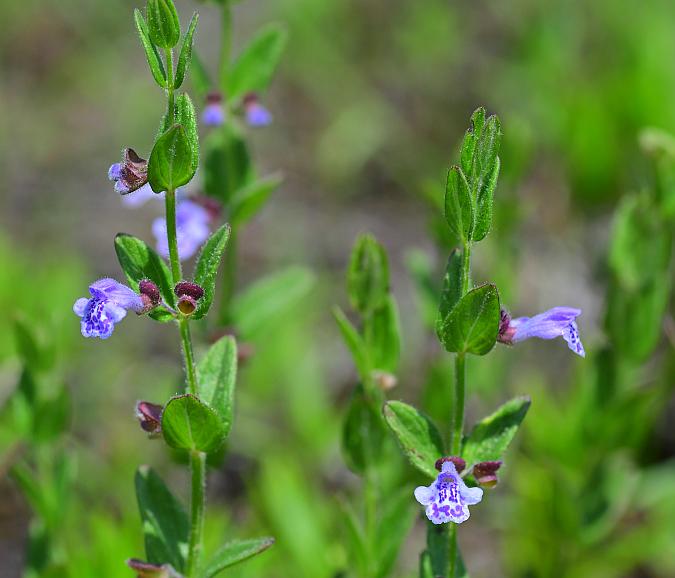Scutellaria parvula Michx.
Small Skullcap

Native
CC = Amb
CW = 3
MOC = 91
© SRTurner
Scutellaria parvula Michx.Small Skullcap | |
 |
Native CC = Amb CW = 3 MOC = 91 |
© SRTurner |
|
Family - Lamiaceae Habit - Perennial forb with fibrous roots and slender, inconspicuous rhizomes.
Stems - Loosely ascending to erect, to 20 cm, often multiple from a spreading base, unbranched or few-branched, 4-angled, glabrous or sparsely to densely pubescent with short, curved, nonglandular hairs and sometimes also longer, spreading gland-tipped hairs.
Leaves - Opposite, sessile or nearly so. Leaf blades 0.5-2.0 cm long, lanceolate to ovate, broadly ovate, or more or less triangular-ovate, rounded to truncate or shallowly cordate at the base or occasionally broadly angled, rounded or bluntly pointed at the tip, the margins entire, the surfaces sparsely pubescent with short, curved hairs or more densely pubescent with short, gland-tipped hairs, sometimes also with dense sessile glands.
Inflorescence - Paired axillary flowers. Pedicels 2-3 mm long, hirsute.
Flowers - Calyces 2.0-3.5 mm long, becoming closed and enlarged to 4-5 mm at fruiting, the tube with a small ridgelike projection on the upper surface, the outer surface sparsely to moderately pubescent with short, curved, nonglandular or straight, gland-tipped hairs, sometimes also with sessile glands. Corollas bilabiate, 6-12 mm long, minutely nonglandular-hairy on the outer surface, bluish purple, the lower lip mottled and/or spotted with white and purple toward the base, the tube S-shaped (bent upward just above the calyx and strongly curved or oblique at or above the throat), the lateral lobes well-developed, spreading, the lower lip broadly depressed ovoid, deeply notched at the tip. Stamens 4, didynamous, included within upper lip. Filaments to 3.5 mm long, white, glabrous. Ovary 4-lobed.
Fruits - Nutlets 1-4 per calyx, 0.9-1.2 mm long, more or less globose, the surface dark brown to black, densely warty or with rounded tubercles, interrupted by a broad, smooth, transverse band.
Flowering - April - July. Habitat - Glades, prairies, savannas, ledges and tops of bluffs, forests, pastures, railroads, roadsides. Origin - Native to the U.S. Lookalikes - Other small species of Scutellaria, such as S. nervosa, S. galericulata, S. bushii. Other info. - This small skullcap is easily overlooked, particularly when not in flower. It is fairly common in its preferred habitat throughout Missouri. Its range is predominantly within a broad band running from Louisiana and eastern Texas up through Minnesota and Wisconsin. Sparser populations exist farther east. The plant is recognized by its short stature, ovate leaves, and small blue flowers paired in the leaf axils. It is distinguished from most of its lookalikes by having entire leaf margins. It is commonly found in rocky open areas of the habitats mentioned above. Photographs taken on Coy Bald, Mark Twain National Forest, Taney County, Mo., 4-28-00, and off Hwy 106, Shannon County, MO., 5-23-03 (DETenaglia); also at Shaw Nature Reserve, Franklin County, MO, 5-7-2007 and 5-26-2021, and Danville Conservation Area, Montgomery County, MO, 5-6-2017 (SRTurner). |